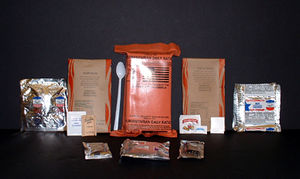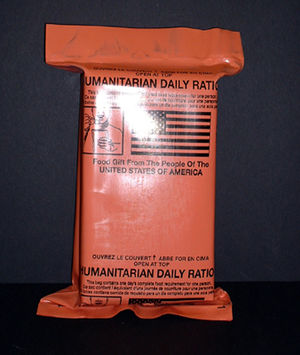Humanitarian daily ration: Difference between revisions
Jump to navigation
Jump to search

imported>George Swan (first draft) |
imported>George Swan (subpages) |
||
| Line 1: | Line 1: | ||
{{subpages}} | |||
[[Image:Human daily ration leaflet as distributed in Afghanistan.jpg|right|thumb|350px|Instructions intended for Afghan refugees for human daily rations.{{Human daily ration leaflet as distributed in Afghanistan.jpg/credit}}]] | [[Image:Human daily ration leaflet as distributed in Afghanistan.jpg|right|thumb|350px|Instructions intended for Afghan refugees for human daily rations.{{Human daily ration leaflet as distributed in Afghanistan.jpg/credit}}]] | ||
[[Image:Humanitarian daily rations and contents.jpg|thumb|Humanitarian daily rations and contents.]] | [[Image:Humanitarian daily rations and contents.jpg|thumb|Humanitarian daily rations and contents.]] | ||
Revision as of 19:23, 18 October 2007
Human daily ration is the name for an emergency ration, with a long shelf-life, intended to be used for refugees during natural diasters, or in conflict areas.[1][2]
The meals are designed to be able to survive being air-dropped, without a parachute.[3] This is safer for the refugees than parachuting large palletes of rations. And it prevents hoarding of the meals by a few individuals.
The meals cost approximately 20 % the cost of a meal ready to eat.[3].
| Shelf life | 36 months at 80 F |
| Weight | 30 ounces |
| Kilo Calories | at least 2200 per package |
| Protein content | 10-13 percent |
| Fat content | 27-30 percent |
| Carbohydrate content | 60 percent |
| Prohibited contents | Any animal products, except a limited amount of dairy prodcuts, below the limit that would cause a problem for a person with lactose intolerance. |
| Infant component | All rations contain a fruit paste, suitable for feeding to infants |
| Utensils' | All rations contain a spoon and a paper towel moistened with a non-toxic, non-alcoholic cleanser |
References
- ↑ 1.0 1.1 TECHNICAL DATA FOR HUMANITARIAN DAILY RATION, United States Department of Defense. Retrieved on 2007-10-18.
- ↑ 2.0 2.1 Operational Rations, United States Defense Logistics Agency. Retrieved on 2007-10-18.
- ↑ 3.0 3.1 3.2 . Humanitarian Daily Rations, DCSA. Retrieved on 2007-10-10.


